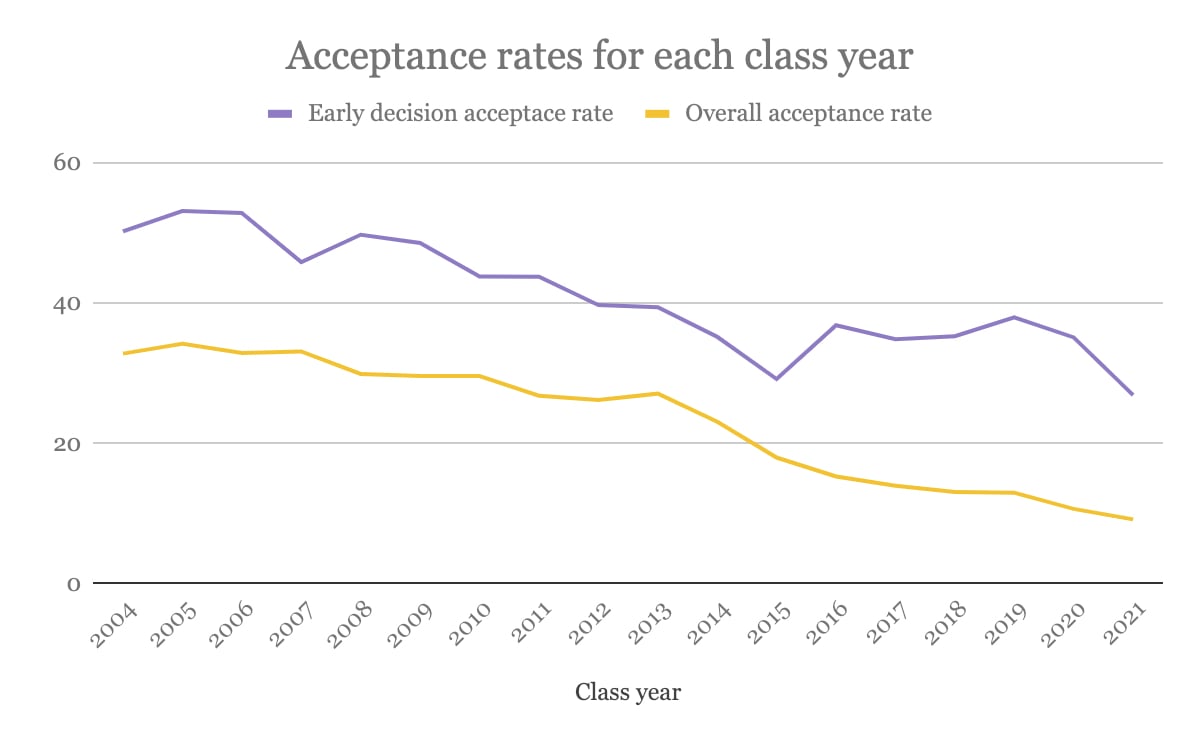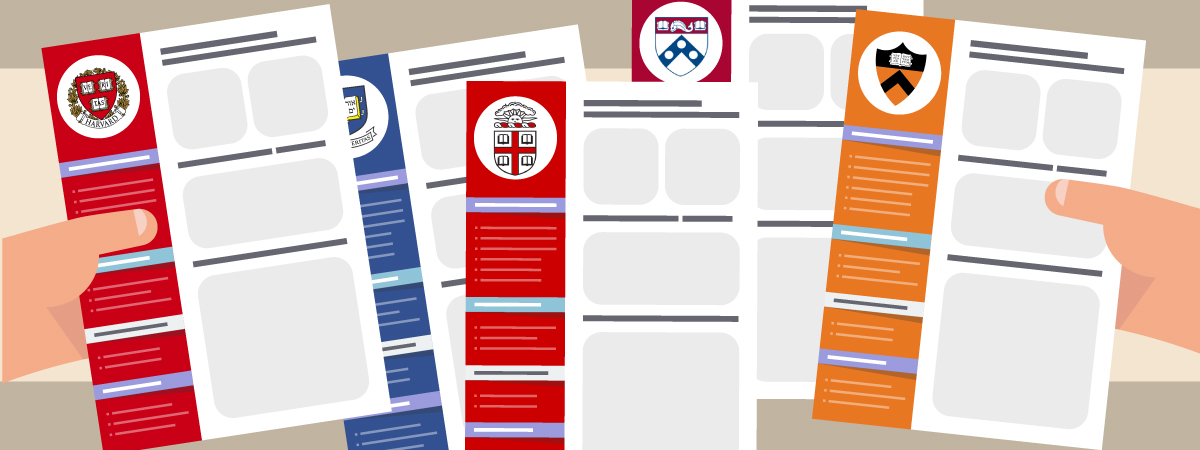The most intriguing twist on the SAT emphasis is applied at Georgetown, one of a handful of schools still offering nonbinding early action. Whereas Harvard knows that nearly all the students admitted EA will enroll, Georgetown knows that most of the academically strongest candidates it admits early will end up at Yale or Stanford if they get in. Georgetown sticks with EA in part because Charles Deacon, its dean of admissions, is a prominent critic of the increased use of binding programs and the sense of panic and scarcity they create among students. Because colleges often highlight the average SAT scores of the students they admit, not just the ones who enroll, a policy like Georgetown's can make a school look better. Suppose a college needs to enroll 2,000 students in its incoming class. Suppose it receives roughly 12,000 applications each year in the regular admissions cycle—a realistic estimate for a prestigious, selective school.
Suppose, finally, that its normal yield for students admitted in the regular cycle is 33 percent—that is, for each three it accepts, one will enroll. So to end up with 2,000 freshmen on registration day, a college relying purely on a regular admissions program would send "We are pleased to announce" letters to 6,000 applicants and hope that the usual 33 percent decided to enroll. A regular-only admissions policy would thus mean that the college's selectivity rate—6,000 acceptances for 12,000 applicants—was an unselective-sounding 50 percent.
Admission StandardsEliteApplicant CompetitionExtremeHow hard is it to get into Penn and can I get accepted? The school has a 8% acceptance rate ranking it #1 in Pennsylvania for lowest rate of acceptance. Last year, 3,740 out of 44,491 applicants were admitted making Penn an extremely competitive school to get into with a very low chance of acceptance – even for applicants with the highest scores and grades.
Academically, it has exceptionally high requirements for admission test scores, generally admitting students who score in the top 4 percent. University of Pennsylvania typically accepts and attracts "A-" average high school students. With over half of admitted students enrolling, acceptance by University of Pennsylvania is a prized outcome for many students. Most incoming freshmen graduated in the top ten percent of their high school class.
The University of Pennsylvania, which ranks among the20 most selective universities in the country, has a highly competitive admissions pool with a low acceptance rate and high average SAT/ACT scores. However, Penn has a holistic admissions process involving other factors beyond your grades and test scores. A strong application essay, supplemental essay, and glowing letters of recommendation can strengthen your application, as can participation in meaningful extracurricular activities and a rigorous course schedule.
Students with particularly compelling stories or achievements can still receive serious consideration even if their test scores are outside of Penn's average range. "There's a widespread perception that applying ED puts students at a disadvantage for financial aid. That may be the case at schools with limited resources, because they know accepted students are committed to coming, so the college could short them on financial aid.
But like everything else in the admissions game, there is no hard and fast rule. At least one study on ed found just the opposite — that financial aid is more generous for Early Decision students because schools sometimes run out of money for regular decision admits". This year, all Ivies reported record numbers of Early Action and Early Decision applications for the class of 2023. But every Ivy League school also reported early admission rate declines compared to the previous year.
All-Ivy League schools have a set of supplemental essays applicants are required to complete in tandem with the standard application. These prompts are designed to give admissions officers a better idea of who you are as an individual, what makes you unique, along other, more personal information about you. While the standard application covers mostly boring admission data such as your GPA and test scores, these supplemental essays are more open-ended in nature. It's paramount that students pen their responses carefully as they play an important role in determining whether or not you end up attending UPenn. Of the 56,333 students who applied to Penn's Class of 2025 in the early and regular rounds, 3,202 were admitted, leading to an overall acceptance rate of 5.68 percent. The 3,202 admitted students to the Class of 2025 included 1,194 students who were admitted through the early decision round.
The admission rate for the ED round was 15 percent out of 7,962 applicants. Last year, 42,205 students applied to Penn's Class of 2024 in the early and regular rounds and 3,404 were admitted, leading to an overall acceptance rate of 8.07 percent. Out of the total 3,404 admitted to the Class of 2024, 1,269 students were admitted through the early decision round.
The admission rate for the ED round was 19.67 percent out of 6,453 applicants. For the Class of 2023, 44,960 students applied to in the early and regular rounds and 3,345 were admitted, leading to an overall acceptance rate of 7.44 percent. College admissions officers focus on yield and generally prefer a well-qualified applicant who they consider likely to attend over an exceptionally qualified candidate who they believe would probably choose not to enroll. Binding ED programs directly impact yield as admitted students are required to enroll. Many EA schools devote significant resources to courting admitted students, many of whom might otherwise enroll elsewhere. In ED programs students start their senior year ready to choose the one college they would most like to attend, and having already taken their SATs.
An early applicant is allowed to make only one ED application, and it is due in the beginning or the middle of November. The college has about a month to deliberate and responds by mid-December. If the answer is no, the student has two weeks to send out regular applications to schools on his or her backup list. If the answer is yes, the process is over, because by virtue of applying early, the student has promised to attend the college if accepted. Mainly through counselors, who know when a student has been admitted ED and agree not to send official transcripts to other schools. If you're wondering how to get into UPenn, you're most likely interested in how difficult the process is.
As mentioned before, although an 8% acceptance rate might seem low, it's relatively high when compared to other Ivy League schools. While it's true that among state colleges, this admissions rate is low, you have to consider it within the context of UPenn's prestige and world-class offerings. Fortunately, the university's admissions process provides you with plenty of opportunities to stand out from the competition and demonstrate why you deserve to attend this school. Penn's four undergraduate schools include a college of arts and sciences, a business school, an engineering school, and a school of nursing.
No matter which school or major students are enrolled in, Penn emphasizes that all undergraduate students receive a thorough foundation in the liberal arts. Many students take courses across all four undergraduate schools and choose from countless interdisciplinary minors and dual degrees. University of Pennsylvania received 44,961 undergraduate applications in 2019, which represents a 1.06% annual growth. Out of those 44,961 applicants, 3,446 students were accepted for enrollment, representing a 7.66% acceptance rate. Brown adopted its current Early Decision policy 18 years ago, yet the university received more Early Decision applications than ever for its Class of 2024.
In 2020, 4,562 students applied for Early Decision, and 800 earned admission — a rate of 17.5 percent. In the Regular Decision round, 32,232 students applied, and 1,733 were accepted — a rate of 5.4 percent. Between Early Decision and Regular Decision, 36,794 students applied to Brown.
Overall, the acceptance rate for Brown's Class of 2024 was approximately 6.9 percent, which is up slightly from 6.6 percent for the Class of 2023, after a trend of rapid decline that spanned a few years. Now suppose that the college introduces an early-decision plan and admits 500 applicants, a quarter of the class, that way. It is very likely to receive at least as many total applications as before—say, 1,000 in the ED program and 11,000 regulars. But now it will have to send out only 5,000 acceptance letters—500 earlies plus 4,500 to bring in 1,500 regular students. Therefore its selectivity will improve to 42 percent from the previous 50, and its yield will be 40 percent rather than the original 33, because all those admitted early will be obliged to enroll.
The real question about the ED skew is whether the prospects for any given student differ depending on when he or she applies. Last fall Christopher Avery, of Harvard's Kennedy School of Government, and several colleagues produced smoking-gun evidence that they do. The authors analyzed five years' worth of admissions records from fourteen selective colleges, involving a total of 500,000 applications, and interviewed 400 college students, sixty high school seniors, and thirty-five counselors.
They found that at the ED schools an early application was worth as much in the competition for admission as scoring 100 extra points on the SAT. For instance, a student with a combined SAT score of 1400 to who applied early was as likely to be accepted as a regular-admission student scoring 1500 to 1600. An early student scoring 1200 to 1290 was more likely to be accepted than a regular student scoring 1300 to 1390.
A total of three essays have to be submitted by applicants — one personal essay and two UPenn-focused supplemental essays. That's because the school's admissions officers want to catch a glimpse of what you might be able to contribute to the campus community through your writing. If you want to know how to get into UPenn, it's helpful to learn more about how admitted students perform on some key academic indicators such as GPA and standardized test scores. Since the UPenn acceptance rate is one of the most selective in the country – when compared to all colleges – it's no surprise that some of the most talented and brightest minds end up getting accepted. Regular Decision applicants numbered at 42,959, of whom 3,788 were accepted to the Class of 2023 — an 8.82 percent acceptance rate.
Among the overall pool of applicants, 49,118 students submitted applications, and 5,183 were admitted at a rate of 10.5 percent. (This acceptance rate is a minor increase from 2018's 10.3 percent.) The total number of students admitted after all things were considered was 5,330. A total of 5,777 Early Action applications flew into the mailboxes of Yale University in the 2020 admissions cycle. Of these 5,777 applicants, 796 were admitted to Yale's Class of 2024, at an EA admission rate of about 13.7 percent. (In 2019, the rate was 13.2 percent for the Class of 2023.) As for Regular Decision, 1,508 students were accepted of 29,443 applicants, at a rate of 5 percent. In total, 2,304 students were accepted from a pool of 35,220 applicants, at a rate of 6.54 percent.
Early Decision plans are almost always single choice (i.e. you agree not to apply ED to any other schools) and binding (i.e. you agree to attend the college if you are accepted ED). Generally, if you're accepted Early Decision, you are required to withdraw all other applications. A major drawback to being admitted ED is limited leverage when negotiating your financial aid package.
From a statistical perspective, applicants with similar credentials are almost always more likely to be admitted when they apply ED. The colleges take three months to consider the applications, and respond by early April. Students have until May 1—the single deadline in this cycle adhered to by most colleges—to send a deposit to the school they want to attend and a "No, thanks" to any other that has accepted them. The colleges tally the returns and adjust the size of their incoming classes by accepting students on their waiting lists. I used The School's Online application portal to access the online form. Portfolio, recommendation letters, resume, personal statement, research statement, academic transcripts and personalised test scores were required.
The school consistently ranks among the top ten universities in the US offering a world standard, diverse array of academic programs, and a generous array of financial aid packages. University of Pennsylvania admissions are extremely selective with a low acceptance rate. Applicants even with above-average scores have very little chance of getting admitted. Essay and LOR should be emphasized while making the application as a good essay and strong recommendation can set you apart in this tough competition.
The admission decision are announced by Mid December for Early Decision applicants and by April 1 for Regular Decision applicants. For the Class of 2021, 1,354 students were admitted through the early admissions process. Total early applications totaled 6,147, yielding an early acceptance rate of 22%. Early applications increased by 6.7% over last year from 5,762 to 6,147. Penn's yield rate—the percentage of accepted students who elect to enroll, divided by the total number of students who are admitted was 70% in 2019.
The takeaway is that an exceptionally high number of those admitted to Penn ultimately choose to attend the university. Part of the explanation for this is that the majority of the class was brought aboard via binding early decision. For comparison, elite schools such as Duke, Northwestern, Notre Dame, and Claremont McKenna all have yield rates under 60%.
In the scattergram, the blue and green represent accepted students. You can see that the great majority of admitted students had a self-reported GPA of 3.7 or higher, a combined SAT score (ERW+M) of over 1200, and an ACT composite of 24 or higher. Hidden beneath the blue and green in the upper right corner of the graph is a lot of red, so keep in mind that even students who seem to be on target for admission get rejected from Penn.
For any school with a single digit acceptance rate, it is best to consider the institution a reach school, even if your scores are on target for admission. This admissions data tells us that most of Penn's admitted students fall within the top 7% nationally on the SAT. For the evidence-based reading and writing section, 50% of students admitted to Penn scored between 700 and 760, while 25% scored below 700 and 25% scored above 760. On the math section, 50% of admitted students scored between 750 and 800, while 25% scored below 750 and 25% scored a perfect 800.
Applicants with a composite SAT score of 1560 or higher will have particularly competitive chances at Penn. Even taking Penn's latest news release at face value, Penn experienced at minimum a nine percent drop in ED applications in 2019 compared to 2018. Accepting Penn's latest numbers also means that Penn's ED acceptance rate for Fall 2019 rose to 19.7% after hitting 18.5% in 2018 when Penn accepted 1,279 ED applicants. Penn has now accepted over half of its Class of 2024, which Penn expects to total 2,400 students, via Early Decision. It means having strong grades and SAT scores by the end of junior year and not thinking that one's record needs to be rounded off or enriched by senior-year performance.
It means that one's family has enough money to be unaffected by the possibility of competitive financial offers. It means that one is emotionally prepared to deal with a rejection if necessary and then to rush regular applications into the mail right away. A counselor at a private school that has long sent many of its graduates to Penn showed me a list of the students from that school who had applied to Penn last year. Some students far down in the class who applied early were accepted; some students thirty or forty places above them in class rank who applied regular were denied. The counselor did not stop to calculate exactly how much an early decision was "worth" in terms of grade-point average, but it clearly made a difference. As of this writing, the University of Pennsylvania has a test-optional admissions policy.
This means that applicants may or may not submit their test scores. But to paint you the whole picture, the average SAT and ACT scores of admitted students are 1460 to 1570 and 33 to 35, respectively. For the class of 2024, UPenn accepted just over 3,400 students out of a total number of 42,205 applicants. This results in roughly an 8% acceptance rate, which is higher than in previous years. In fact, it's the first time the UPenn acceptance rate has increased in the past five years.
That figure combines those who applied through regular decision with those who were deferred from early decision. However, early decision may not be the best choice of action for students who need the fall semester of their senior year to improve test scores, GPA, or activities profile. In terms of extracurricular activities, it is critically important to have some type of "hook" when applying to Penn. For example, there are over 1,000 NCAA Division I athletes competing for the Quakers. Some of those individuals were recruited by a Penn coach, giving them a serious edge in the admissions process.


























No comments:
Post a Comment
Note: Only a member of this blog may post a comment.